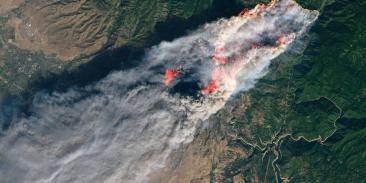U.S. Tightens Limits on Oil and Gas Methane to Address One of Nation’s Largest Pollution Sources
Statement of Environmental Defense Fund President Fred Krupp
(Dubai, U.A.E. – Dec. 2, 2023) The U.S. Environmental Protection Agency today finalized tougher clean air standards that, for the first time, establish protective limits on methane pollution from both new and existing oil and gas sources.
The safeguards will reduce tens of millions of tons of climate-damaging methane and other toxic, smog-forming pollution from oil and gas leaks, venting and flaring – strengthening vital climate and health protections for communities living near this industrial activity.
EPA’s common-sense protections address one of the single largest sources of climate-destabilizing pollution in the U.S. and the world. Over a quarter of the warming the world is experiencing today is due to methane emissions from human activities.
“As the world gathers to tackle the climate crisis, the U.S. now has the most protective methane pollution limits on the books. EPA’s limits on oil and gas methane pollution are a vital win for the climate and public health, dramatically reducing warming pollution and providing vital clean air protections to millions of Americans. With other countries also zeroing in on methane as a key climate risk, it’s a signal to operators worldwide that clean-up time is here.
“EPA has shown tremendous leadership in establishing these leading clean air standards and we look forward to working with states and EPA to move quickly on implementation. The communities who fought long and hard for these protections now need to begin to reap their benefits.”
- Fred Krupp, President, Environmental Defense Fund
Environmental Defense Fund research on the demographics of people living near active oil and gas wells finds that nearly 18 million individuals live within one mile of a well site, including disproportionately large numbers of communities of color, people living below the poverty line, older individuals and young children in many counties with active drilling across the U.S.
The standards address two of the largest sources of U.S. oil and gas methane pollution, requiring regular leak monitoring at existing and new well sites and a phase-out of intentionally emitting devices widely used across industry. The rules also include a program to quickly address the largest leaks and malfunctions – known as super-emitters – and improved steps to curtail wasteful flaring (burning off excess gas).
The U.S. oil and gas industry emits 16 million metric tons of methane annually, which has the same near-term climate impact as 350 coal-fired power plants. Reducing oil and gas methane pollution alongside a rapid shift to a clean energy is critical to avoid the worst climate impacts and protect the health of communities. Now that EPA has finalized these vital protections, state and federal agencies must ensure that these rules are implemented and enforced swiftly.
With more than 3 million members, Environmental Defense Fund creates transformational solutions to the most serious environmental problems. To do so, EDF links science, economics, law, and innovative private-sector partnerships to turn solutions into action. edf.org
Media Contact
Latest press releases
-
Groups File Lawsuit Challenging Trump EPA Final Rule That Delays Methane Pollution Protections from Oil and Gas Industry
December 4, 2025 -
New Statewide Survey: As Electricity Demand and Costs Skyrocket, Arizonans Support Building More Wind and Solar Energy
December 4, 2025 -
Trump Administration Announces Plan to Weaken Fuel Economy Standards for Cars and Trucks
December 3, 2025 -
Trump EPA Proposal Lowballs Risk of Cancer-causing Formaldehyde
December 3, 2025 -
New York Finalizes Greenhouse Gas Reporting Requirements for Major Polluters
December 2, 2025 -
Canada-Alberta MOU a Disappointing Retreat on Oil & Gas Methane Regulation
November 27, 2025











